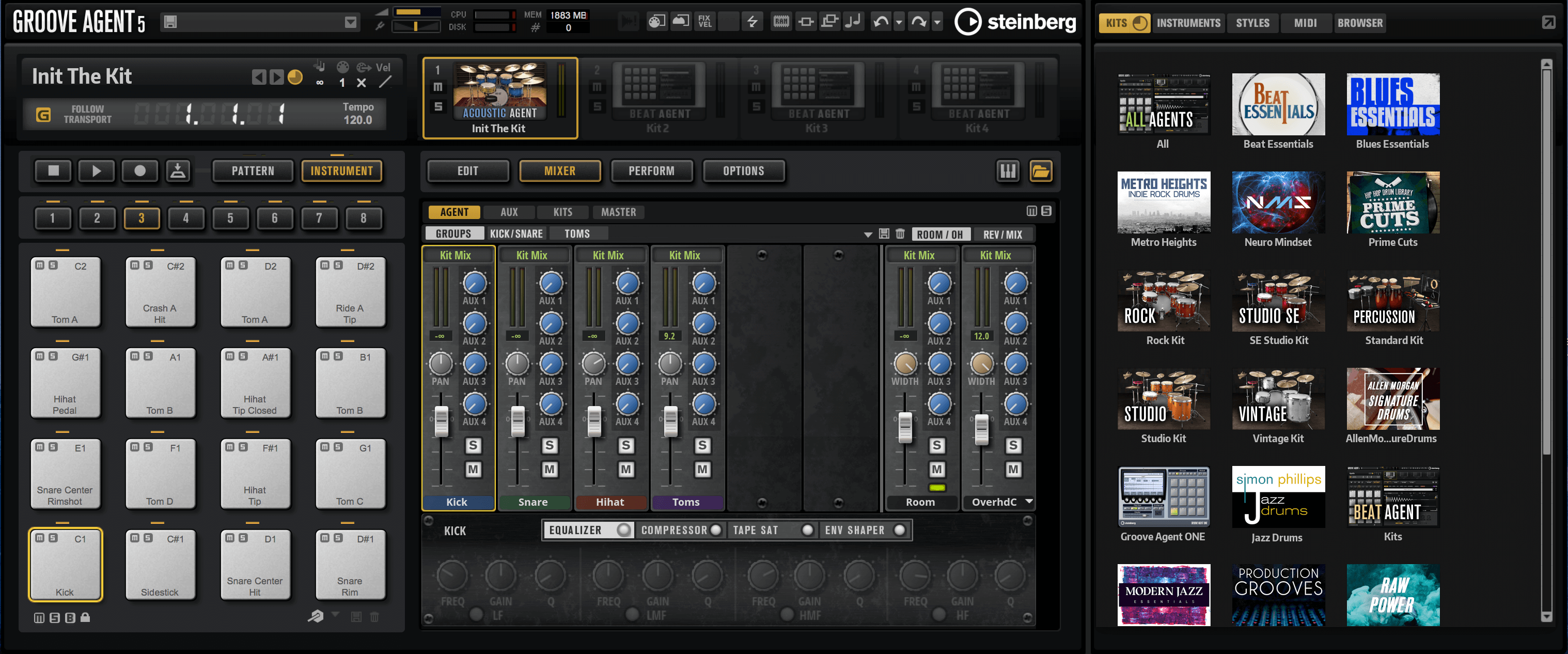
- GROOVE AGENT 4 IMPORT KITS HOW TO
- GROOVE AGENT 4 IMPORT KITS PATCH
- GROOVE AGENT 4 IMPORT KITS FULL
- GROOVE AGENT 4 IMPORT KITS SERIES
You can define these names directly from within the Drum Editor (just double-click on an instrument name to edit it), or you can do so from the Drum Map Setup panel. Cubase solves both of these problems with Drum Maps.Īt their most basic, Drum Maps associate a drum-instrument name with a MIDI note, and it is these names that are displayed in the Drum Editor’s instrument list. This can be a problem for producers when they want to experiment to hear how a rhythm part will sound through different drum-kit banks and/or instruments – the different sounds associated with each note can be comically different.Ī similar issue exists if you’re playing drum parts using a controller, because different instruments and sound banks may require you to learn different key layouts, or to reprogram your pad controller.
GROOVE AGENT 4 IMPORT KITS PATCH
Where one drum patch or sample bank may assign a kick drum to note C1, another may have a tambourine assigned to that note. The problem is that there is no common template or specification that governs the specific mapping of drum sounds to note numbers. However, whether it’s external hardware, plug-in software, or synthesised or sampled drum sounds (or a mixture of the two), nearly all of these drum-sound sources have one thing in common: drum ‘kits’ are stored as patches in which each drum sound is assigned to, and therefore triggered by, a specific MIDI note. – For all beginner to Intermediate Steinberg Groove Agent 4 users.T h ere are loads of ways to generate drum and percussion sounds in the studio these days – we’re spoilt for choice with all sorts of beat-making methods.

GROOVE AGENT 4 IMPORT KITS HOW TO
You’ll even see How to Slice Imported Loops to Create Unique Effects and more. Wrapping up the series, Mark shows how Percussion Agent’s Sub-Style Sliders and Parameters allow you to Balance Individual Drum Sounds, and Draw in Custom Automation through Cubase.

Once you’ve created a pattern you like, you’ll see how to Export it to Cubase for Further Editing and then Import it Back into Groove Agent 4. When you’re ready to spice up a pattern, Mark shows you How the Quantize, Auto-Fill, and Swing Parameters can be Edited to Add a More Realistic Feel to Your Drum Tracks. Complexity, Intensity, and Auto-Complexity are also demonstrated to give you Complete Control Over the Patterns You Create. Getting even more detailed, Mark showcases the Style Player, Library, and Performance Dial and how they play an integral part in Groove Agent 4. Mark then explains how to integrate Groove Agent 4 with Cubase for editing. Jam Mode is then demonstrated showing you how easy it is to Play Along with Loops, Intros, Fills, and More.
GROOVE AGENT 4 IMPORT KITS FULL
Once you’re comfortable with the Mixer, dive deeper to realize its full potential by exploring the various Mixer Pages and Aux Effects. Mark also reveals how the Integrated Mixer allows you to Balance Your Sound and Feel. Then discover how Blending Drums Together can help you Create Unique Hybrid Kits to Personalize Your Style. From there, you’ll learn about Agents and Editing Drum Sounds to Make the Right Kit for Your Track. Once you’re familiar with the basics, Mark walks you through Loading Kits and Setting them Up with Samples so you can get started making music. Mark jumps right in and shows you all the Basics of the Groove Agent User Interface so you’ll know how to Navigate and Access all of the innovative features of Groove Agent 4.
GROOVE AGENT 4 IMPORT KITS SERIES
Steinberg Groove Agent expert returns with “Groove Agent 4 Explained”, a series packed full of great information to help you get the most out of this exciting percussive tool.

Groove Agent 4 Explained TUTORiAL TEAM MAGNETRiXX | | 450 MB


 0 kommentar(er)
0 kommentar(er)
